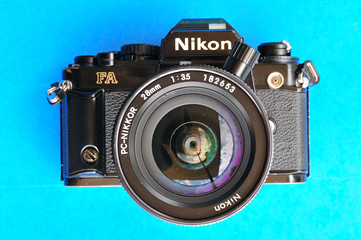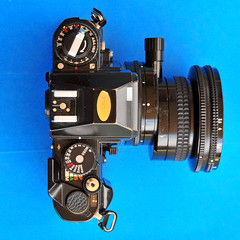Perspective control lens
Perspective control lenses are produced for SLR cameras to allow control of converging vertical lines typical when the camera is pointing upward or (less commonly) downward, especially useful for architectural photography. Compared with a technical camera, which allows full movement of lens and film back, a shift lens only offers limited horizontal and vertical movement. They are also known as PC ("perspective control") in English, or PA ("Perspektivischer Ausgleich") in German. Shift lenses are usually wide angle since the greater subject distance with long focus (telephoto) lenses results in much reduced convergance of vertical lines.
Perspective control tilt/shift lenses provide the additional feature of tilting the lens, bringing them closer to the full movements of technical cameras. The additional tilt movement does not affect perspective but allows the plane of focus to be altered, bringing more of the subject into focus.
Construction
In order to allow movement, the lens must be constructed so that image coverage will be larger than the usual image size. This means that the projected image extends beyond the normal frame, resulting in a more complex lens usually with smaller maximum aperture. The lens itself can be physically shifted respective to the camera (slid by hand or screw adjuster) either vertically, horizontally, or in combination.
Because of the movement, shift lenses usually do not have automatic diaphragms and must be used in stop-down mode. Also it is common for the manufacturer to stipulate that smaller apertures should be used when the lens is shifted.
Usage
In use the camera will be set up on a tripod and pointed at the subject with the line of sight near horizontal. Then (usually) the lens will be shifted upwards bringing the subject down into view without affecting perspective. The effect is exactly the same as moving the point of view (i.e. camera) upwards. Similar usage applies whether the required shift is horizontal or downwards.
When the lens is shifted the viewfinder image darkens as effective aperture is reduced due to the oblique path of light rays. TTL metering will automatically compensate for this.
Photo editing software can correct perspective, along with other optical distortion, largely replacing the need for shift lenses.
|
|
| ||||||
|
|
| ||||||
|
Movements of the Nikon PC-Nikkor 28mm f/3.5 shift lens | ||||||||





